Announcing the AAMA
A global archive with movement data collected across three decades logs changes in the behaviour of Arctic animals
Warmer winters, earlier springs, shrinking ice, and increased human development—the Arctic is undergoing dramatic changes that are impacting native animals. Researchers from around the world have now established an archive for data documenting movements of animals in the Arctic and Subarctic, hosted on the Movebank platform at the Max Planck Institute of Animal Behavior in Radolfzell, Germany. With the Arctic Animal Movement Archive, scientists can share their knowledge and collaborate to ask questions about how animals are responding to a changing Arctic. Three recent studies from the archive reveal large-scale patterns in the behaviors of golden eagles, bears, caribou, moose, and wolves in the region, and illustrate how the archive can be used to recognize larger ecosystem changes.

Caribous migrate over long distances during the year. © iStock/Geoffrey Reynaud
Researchers have long been observing the movements and behaviour of animals in the Arctic. However, it has been difficult to discover and access these data. To address this problem, an international team led by Sarah Davidson, data curator at the Max Planck Institute of Animal Behavior in Radolfzell, and Gil Bohrer, professor at the Ohio State University, have established a NASA-funded global data archive for studies of animal migration in the Arctic and Subarctic.
The aim of the Arctic Animal Movement Archive is to network scientists and promote their cooperation. This is particularly important because the Arctic region extends around the world. Researchers from over 100 universities, government agencies and conservation groups across 17 countries are involved in the archive, which is hosted on Movebank, a research platform developed by Martin Wikelski, director at the Max Planck Institute. “Our goal is to use the archive to build a global community across institutions and political boundaries”, says Wikelski. The archive currently contains over 200 projects with the movement data of more than 8,000 marine and terrestrial animals from 1991 to the present.
Researchers recently published a set of discoveries bringing together data and expertise using the archive. By comparing movements of more than 100 golden eagles from 1993 to 2017, researchers found that immature birds migrating north in the spring arrived earlier following mild winters. However, the arrival time of adults has remained rather constant, regardless of conditions at their breeding grounds, with consequences for nesting and chick survival. “Our approach revealed the importance of assessing data that span generations and decadal climate patterns, that when ignored can dramatically affect our results and consequently management strategies”, says Scott LaPoint, scientist at Black Rock Forest.

Golden eagles return to their breeding grounds in the Arctic after the winter. © Adobe Stock/Tomas Hulik
A second study of more than 900 female caribou from 2000 to 2017 found that more northern herds are giving birth earlier in the spring, while the calving dates of more southern populations have not shown the same change. “The ability to look at biological processes, like birth, at such a large scale, across populations and subspecies and over millions of square kilometres, is unprecedented for a species in such a remote and harsh environment. These results reveal patterns that we would not have suspected, and point to further lines of inquiry about everything from caribou evolution to their ability to adapt to environmental changes moving forward," explains Elie Gurarie from the University of Maryland.
A third analysis looking at the movement speeds of bears, caribou, moose, and wolves from 1998 to 2019 showed that species respond differently to seasonal temperatures and winter snow conditions. “How animals respond to variable weather conditions through movement will have interesting implications for species competition and predator-prey dynamics,” says Peter Mahoney, who conducted this research while at the University of Washington.
In addition to the hundreds of studies already included in the archive, the resource is continually growing, as data are transmitted from animals in the field and as more researchers join. This should help to detect changes in the behaviour of animals and ultimately in the entire Arctic ecosystem. “We are also providing a much-needed baseline of past behaviors and movements”, says Davidson. “This can be used to improve wildlife management, address critical research questions, and document changes in the Arctic for future generations."
How to Participate
AAMA boundary

The geographic scope of the AAMA defined as that of the Arctic Monitoring and Assessment Programme, which includes marine areas, and Subarctic land regions represented as areas classified as "boreal forests/taiga" by the Nature Conservancy. This boundary, along with the density of participating animal locations as of Nov 2019, is shown above. (see Davidson et al. 2020).
Contribute and Collaborate
We are ecstatic to announce the launch of the Arctic Animal Movement Archive! Hundreds of researchers worked together to create a dynamic collaborative archive documenting 3 decades of animal movement in the Arctic & subarctic. #DataSharing https://t.co/YlBF6pHnng pic.twitter.com/rX5wZg71g1
— Movebank (@MovebankTeam) November 5, 2020
Read below for how to participate in the AAMA by contributing participating datasets or initiating new collaborations and beneficial uses of the data.
Data Owners
To include your own data from the Arctic and Subarctic in the AAMA, you can create a study and add data. Contact us here for assistance and to have your existing study reviewed and added to the list of participating studies. Beyond having data organized on Movebank, requirements for participation include:
- Owners are committed to keeping the studies publicly discoverable and considering requests for the use of their data for collaborations.
- Participating data are quality checked to ensure the data are accurately stored and include sufficient metadata.
- If data are not publicly available, extra steps will be taken to ensure that owner contact information does not become obsolete.
Data Users
The AAMA provides a source of on-animal sensor data from the Arctic and Subarctic for a variety of beneficial uses, including but not limited to:
- Biodiversity and conservation assessments
- Movement ecology research
- Remote sensing and environmental models
- Wildlife management and monitoring
Please read our tips on collaborations using Movebank for guidance on initiating projects and data sharing requests. As described above, the AAMA is composed of both public and controlled-access studies. While many studies are open to the public, we strongly urge users to contact data owners about proposed uses, as they will have valuable input about ecological context. Also see our citation guidelines, general Movebank terms of use, and user agreement. Contact [email protected] for help negotiating data sharing.
To search participating studies, review the table here for studies relevant to your proposed use. The table contains links to each study for additional information.
See Movebank's user manual for general instructions on browsing and accessing data. Searching for "AAMA" on the Tracking Data Map will filter your results for participating studies.


Add the first post in this thread.